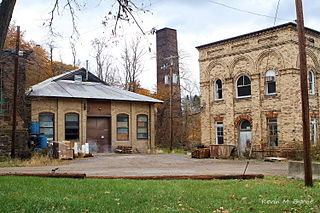Related Research Articles

Oldtown is an unincorporated community and census-designated place (CDP) in Allegany County, Maryland, United States, along the North Branch Potomac River. As of the 2010 census it had a population of 86.

There are more than 1,500 properties and districts listed on the National Register of Historic Places in the U.S. State of Maryland. Each of the state's 23 counties and its one county-equivalent has at least 20 listings on the National Register.

The National Archives Site is an archeological site at the National Archives facility in College Park, Prince George's County, Maryland. The site contains archeological remains from prehistoric settlements during the Late Archaic period, c. 4000-1500 B.C. Stone artifacts recovered through archeological testing indicate that this camp served as a place of stone tool manufacture and probably as a staging point for hunting and foraging. Physical integrity of the prehistoric component is high, with little plow disturbance or admixture with artifacts from other periods. The presence of a small number of other artifacts, including the projectile points, a spokeshave, and utilized flakes, indicates that the site also served in other hunting and foraging pursuits. It is one of a relatively small percentage of known prehistoric properties in Maryland with undisturbed archeological deposits.
Nottingham is a small town on the Patuxent River in Prince George's County, Maryland, United States. It contains an archaeological site which was listed on the National Register of Historic Places in 1975.
Walker Prehistoric Village Archeological Site is an archeological site located near Poolesville, Montgomery County, Maryland. The site is a large Late Woodland village located on Selden Island in the Potomac River. Excavations carried out in the 1930s and 1940s revealed a 40-foot section of a palisade, circular house patterns, shallow oval pits and cylindrical pits, and flexed burials interred in the floors of the houses.
Aisquith Farm E Archeological Site is an archaeological site near Riva in Anne Arundel County, Maryland. It is one of several small sites located within the confines of Aisquith farm. It is associated with the Early and Middle Woodland periods of cultural development in Anne Arundel County. The site is significant as a base camp property type.
The Katcef Archeological Site is an archaeological site near Crofton in Anne Arundel County, Maryland. It is a series of overlapping base camp sites dating from the Clovis phase of the Paleoindian period, through to the Late Woodland period. The primary era of site utilization was during the Late Archaic period.
The Elkridge Site, or Elkridge Prehistoric Village Archeological Site, is an archaeological site near Elkridge in Anne Arundel County, Maryland. It is located on a 20-foot (6.1 m) terrace above the Patapsco River and extends 1,200 feet (370 m) along the river and inland from 20 to 400 feet. It is the only known Woodland period riverine-oriented village site in the tidewater Patapsco River valley which has at least partially escaped the totally destructive forces of gravel quarrying. The site appears to have been abandoned as a permanent village in the early 16th century.

Barton Village Site, also known as the Herman Barton Indian Village Archeological Site, is a large, multi-component archaeological site near Cumberland in Allegany County, Maryland.

The Mount Savage Historic District is a national historic district in Mount Savage, Allegany County, Maryland. It comprises 189 19th and 20th century buildings, structures, and sites within this industrial community northwest of Cumberland. The structures reflect the community's development as a center of the iron, coal, brick, and railroad industries from the 1830s to the early 20th century. Included are a set of vertical-board duplexes on Old Row built about 1840, and possibly the earliest examples of workers' housing remaining in the region.

The Inns on the National Road is a national historic district near Cumberland, Allegany County, Maryland. It originally consisted of 11 Maryland inns on the National Road and located in Allegany and Garrett counties. Those that remain stand as the physical remains of the almost-legendary hospitality offered on this well-traveled route to the west.
Buckingham Archeological Site is an archaeological site near Berlin in Worcester County, Maryland. It is one of the few known Woodland period village sites in the coastal marsh areas of the Atlantic Coast section of Maryland. The site falls within the general vicinity of an Assateague Indian town. It is located four miles east of the Sandy Point Site, both including the southernmost reported occurrence of Townsend Series ceramics on the coastal section of the Eastern Shore.
The Sandy Point Site, or Sandy Point Archeological Site, is an archaeological site near Ocean City in Worcester County, Maryland. It contains the southernmost component of the Townsend Series on the Delmarva Peninsula. It is also one of the few known Woodland period village sites in this area. These traits are shared by the nearby Buckingham Archeological Site.
Willin Village Archeological Site is an archaeological site near Eldorado in Dorchester County, Maryland. The Sussex Society of Archeology and History extensively excavated this site between 1951 and 1953. They identified grooved axes and stemmed points indicating use by Archaic peoples. It was possibly the site of a village during the Late Woodland period.
The Bumpstead Archeological Site is an archeological site located near Elkton, Cecil County, Maryland. The site is one of a group of interrelated sites illustrating the various phases of stone tool production and living area activities.
The Heath Farm Camp Archeological Site is an archeological site located near Elkton, Cecil County, Maryland. The site is one of a group of interrelated sites illustrating the various phases of stone tool production and living area activities.
The Heath Farm Jasper Quarry Archeological Site is an archeological site located near Elkton, Cecil County, Maryland. The site is one of a group of interrelated sites illustrating the various phases of stone tool production and living area activities.
The Iron Hill Cut Jasper Quarry Archeological Site is an archeological site located near Elkton, Cecil County, Maryland. The site is one of a group of interrelated sites illustrating the various phases of stone tool production and living area activities.
The McCandless Archeological Site is an archeological site located near Elkton, Cecil County, Maryland. The site is one of a group of interrelated sites illustrating the various phases of stone tool production and living area activities.
The Grear Prehistoric Village Site is an archeological site located near Crystal Beach, Cecil County, Maryland. The site was discovered and tested by an amateur archeologist in 1971. It is the northernmost known Late Woodland period village site on the Eastern Shore of the Chesapeake Bay outside of the Susquehanna River Basin.
References
- 1 2 "National Register Information System". National Register of Historic Places . National Park Service. April 15, 2008.
- ↑ "Maryland Historical Trust". National Register of Historic Places: Shawnee Old Fields Village Archeological Site. Maryland Historical Trust. 2008-10-05.

